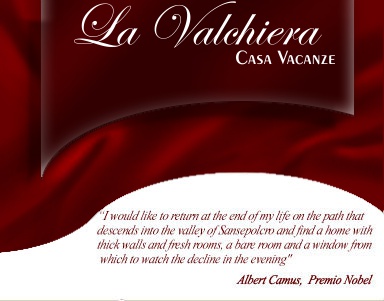Brief links
http://www.umbriaearte.it/castello_bufalini.htm
http://www.comune.sansepolcro.ar.it/
http://www.vasentiero.it/treno/tevere.htm
http://www.parks.it/riserva.alpe.luna/arr.html
http://it.wikipedia.org/wiki/Convento_di_Montecasale
http://www.comunemonterchi.it/
Appealing and anywere near places:
Monterchi - Anghiari - Caprese Michelangelo - Città di Castello – La Verna – Camaldoli - Eremo di Montecasale - Eremo Cerbaiolo - Lago di Montedoglio - Castello Bufalini (San Giustino) - Terme di Bagno di Romagna...
The River Afra
Fascinating, tributary terse of Tevere ,Cross-refer to rites of ancient time ,which were celebrated on his bank and this let the sign on the memories of the inhabitants valtiberine until in our times. One recent research pointed out one pagan ritual which consisted of the immersion on the torrent water of the pregnant woman with this ritual there was a divine protection for the childbirth and to have plentiful milk. The custom was said to wash the dresses of the children who had persistent diseases. When the summer came was, and is in our days too, custom to bathe on Afra whirlpool.
For its best stretch (1200 mt ) it flows in the 30 hectares of the property.
The roman street
Many clues have led historians to believe the route of this street was roman.
Part of this old street, still intact in its straight walls and in some parts of the pavement, is found along the bank of Afra near the “Madonnina del fiume." An Franciscan itinerary hang out in our days is “Verna” reach “Cerbaiolo” e “Montecasale” ( all Franciscan known places) crossing the natural reserve of “Alpe della Luna”
Valchiera
After the invention of Guttemberg increased enormously the demand for paper. The Valchiera was the place where his work was done. The raw material was made from rags. After a screening accurate were crumbled manually. They were then immersed for days in the lime and then passed to the plumbing stack where they were beaten until it becomes a mush. The worker, with clever move, he picked up a thin piece on a felt, once pressed and dried it was born a sheet of paper.
Gualchiera
Gualchiera comes probably from Germanic “walkan” .Maybe the diffusion of this kind of hydraulic machine derives from Longobard influence. (see the wonderful sighting tower in Montagna-La Villa). The structure was made by a mill which operated the manufactured process. That was a mechanic process that gave lightness, compactness and softness to woollen dry goods. It worked using hydraulic energy, and that's why this machine was usually situated on large structure near rivers with a fast slope. The meaning, which it had later, can be very interesting; la Gualca is a plant that grew on Afra banks .Her leaves were used to colour the wool of a wonderful blue .
|









